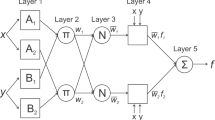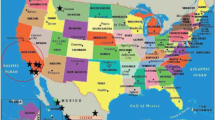Abstract
In earthquake studies, different methods are used in modeling of the crustal motions. In case of obscurity data structure, different approaches are needed in solving motion problems. In this paper, a new spatial algorithm has been developed which is based on adaptive fuzzy neural network (AFNN) approach for the prediction of the crustal motion velocities. In order to find the fuzzy class numbers regarding the network model formed by the fuzzification of the studied area, subtractive clustering algorithm is used. In determining the membership function, utilization of the variogram function which models the relationship that depends on distance among spatial data is proposed. The Marmara Region, Turkey, is used as the case for this study. In order to evaluate the performance of the approach, the kriging method is also utilized in the prediction and the results obtained from both methods are compared based on the mean-square-error criteria. It is observed that the AFNN approach yields results which are as effective as those of kriging. Consequently, it is shown that the AFNN approach will contribute to earthquake studies.













Similar content being viewed by others
Explore related subjects
Discover the latest articles, news and stories from top researchers in related subjects.References
Aboonasr, S.F.G., Zamani, A., Razavipour, F., Boostani, R.: Earthquake hazard assessment in the Zagros Orogenic Belt of Iran using a fuzzy rule-based model. Acta Geophys. 65, 589–605 (2017)
Ahumada, A., Altunkaynak, A., Ayoub, A.: Fuzzy logic-based attenuation relationships of strong motion earthquake records. Expert Syst. Appl. 42, 1287–1297 (2015)
Alavi, A.H., Gandomi, A.M.: Prediction of principal ground-motion parameters using a hybrid method coupling artificial neural networks and simulated annealing. Comput. Struct. 89, 2176–2194 (2011)
Alimoradi, A., Pezeshk, S., Naeim, F., Frigui, H.: Fuzzy pattern classification of strong ground motion records. J. Earthq. Eng. 9(3), 307–332 (2005)
Ameur, M., Derras, B., Zendagui, D.: Ground motion prediction model using adaptive neuro-fuzzy inference systems: an example based on the NGA-West 2 data. Pure Appl. Geophys. 175, 1–16 (2017)
Andalib, A., Zare, M., Atry, F.: A fuzzy expert system for earthquake prediction, case study: the Zagros range. Proc. Intell. Transp. Syst. 15(3), 1168–1178 (2016)
Andrić, J.M., Lu, D.-G.: Fuzzy probabilistic seismic hazard analysis with applications to Kunming city, China. Nat. Hazards 89, 1031–1057 (2017)
Asencio-Cortés, G., Martínez-Álvarez, F., Troncoso, A., Morales-Esteban, A.: Medium–large earthquake magnitude prediction in Tokyo with artificial neural networks. Neural Comput. Appl. 28, 1043–1055 (2017)
Baldovino, R.G., Dadios, E.P.: A hybrid fuzzy logic–PLC-based controller for earthquake simulator system. JAC III 20, 100–105 (2016)
Bodri, B.: A neural-network model for earthquake occurrence. J. Geodyn. 32, 289–310 (2001)
Chen, M.S., Wang, S.W.: Fuzzy clustering analysis for optimizing fuzzy membership functions. Fuzzy Sets Syst. 103, 239–254 (1999)
Cheng, C.B., Lee, E.S.: Applying fuzzy adaptive network to fuzzy regression analysis. Comput. Math Appl. 38, 123–140 (1999)
Cheng, C.B., Lee, E.S.: Fuzzy regression with radial basis function network. Fuzzy Sets Syst. 119, 291–301 (2001)
Cressie, N.A.C.: Statistics for spatial data. Wiley, Canada (1993)
Giacinto, G., Paolucci, R., Roli, F.: Application of neural networks and statistical pattern recognition algorithms to earthquake risk evaluation. Pattern Recogn. Lett. 18, 1353–1362 (1997)
Goovaerts, P.: Geostatistics for natural resources evaluation. Oxford University Pres, New York (1997)
Huang, C., Leung, Y.: Estimating the relationship between isoseismal area and earthquake magnitude by a hybrid fuzzy-neural-network method. Fuzzy Sets Syst. 107, 131–146 (1999)
Isaaks, E.H., Srivastava, R.M.: An introduction to applied geostatistics. Oxford University Pres, New York (1989)
Ishibuchi, H., Tanaka, H.: Fuzzy neural networks with fuzzy weights and fuzzy biases. In: Proceedings of 1993 IEEE International Conference on Neural Networks, San Francisco, pp. 1650–1655 (1993)
Jang, J.-S.R.: ANFIS: adaptive-network-based fuzzy inference system. IEEE Trans. Syst. Man Cybern. 23(3), 665–684 (1993)
Jang, J.-S.R., Sun, C.-T.: Neuro-fuzzy modeling and control. Proc. IEEE 83(3), 378–406 (1995)
Last, M., Rabinowitz, N., Leonard, G.: Predicting the maximum earthquake magnitude from seismic data in Israel and its neighboring countries. PLoS ONE 11(1), e0146 (2016)
Lee, S.C., Han, S.W.: Neural-network-based models for generating artificial earthquakes and response spectra. Comput. Struct. 80, 1627–1638 (2002)
Muller, S., Garda, P., Muller, J.D., Cansi, Y.: Seismic events discrimination by neuro-fuzzy merging of signal and catalogue features. Phys. Chem. Earth (A) 24(3), 201–206 (1999)
Negarestani, A., Setayeshi, S., Maragheh, M.G., Akashe, B.: Estimation of the radon concentration in soil related to the environmental parameters by a modified Adaline neural network. Appl. Radiat. Isotops 58, 269–273 (2003)
Reilinger, R., Mc Clusky, S., Vernant, P., Lawrence, S., Ergintav, S., Cakmak, R., Ozener, H., Kadirov, F., Guliev, I., Stepanyan, R., Nadariya, M., Hahubia, G., Mahmoud, S., Sakr, K., ArRajehi, A., Paradissis, D., Al-Aydrus, A., Prilepin, M., Guseva, T., Evren, E., Dmitrotsa, A., Filikov, S.V., Gomez, F., Al-Ghazzi, R., Karam, G.: GPS constraints on continental deformation in the Africa–Arabia–Eurasia continental collision zone and implications for the dynamics of plate interactions. J. Geophys. Res. Solid Earth 111(B5): Art. No. B05411 (2006)
Rovithakis, G.A., Vallianatos, F.: A neural network approach to the identification of electric earthquake precursors. Phys. Chem. Earth (A) 25(3), 315–319 (2000)
Sinclair, A.J., Blackwell, G.H.: Applied Mineral Inventory Estimation. Cambridge University Press, Weat Nyack (2002)
Stein, A., Meer, F., Gorte, B.: Spatial statistics for remote sensing. Kluwer Academic, Hingham (1999)
Takagi, T., Sugeno, M.: Fuzzy identification of systems and its applications to modelling and control. IEEE Trans. Syst. Man Cybernet. 15, 116–132 (1985)
Tercan, A.E., ve Saraç, C.: Maden Yataklarının Değerlendirilmesinde Jeoistatistiksel Yöntemler, TMMOB Jeoloji Mühendisleri Odası Yayınları: 48, Ankara, Türkiye (1998)
Tosunoğlu, N.G.: Prediction of crustal motion velocities which is constitute earthquake by the fuzzy adaptive network in spatial statistics. Ph.D. Thesis, Institute of Science, University of Ankara, Ankara, Turkey (2007) (in Turkish)
Wyss, M.: Why is earthquake prediction research not progressing faster? Tectonophysics 338, 217–223 (2001)
Zadeh, L.A.: Fuzzy sets. Inf. Control 8, 338–353 (1965)
Zhang, J., Yao, N.: The geostatistical framework for spatial prediction. Geo-Spatial Inf. Sci. 11(3), 180–185 (2008)
Zhong, M., Zhang, Q.: Prediction of reservoir-induced earthquake based on fuzzy theory. In: Proceedings of the Second International Symposium on Networking and Network Security (ISNNS’10), Jinggangshan, pp. 101–104 (2010)
Author information
Authors and Affiliations
Corresponding author
Additional information
This paper is based on the Ph.D. thesis of Dr. Nuray Güneri Tosunoğlu [32].
Rights and permissions
About this article
Cite this article
Güneri Tosunoğlu, N., Apaydın, A. A New Spatial Algorithm Based on Adaptive Fuzzy Neural Network for Prediction of Crustal Motion Velocities in Earthquake Research. Int. J. Fuzzy Syst. 20, 1656–1670 (2018). https://doi.org/10.1007/s40815-018-0483-6
Received:
Revised:
Accepted:
Published:
Issue Date:
DOI: https://doi.org/10.1007/s40815-018-0483-6




